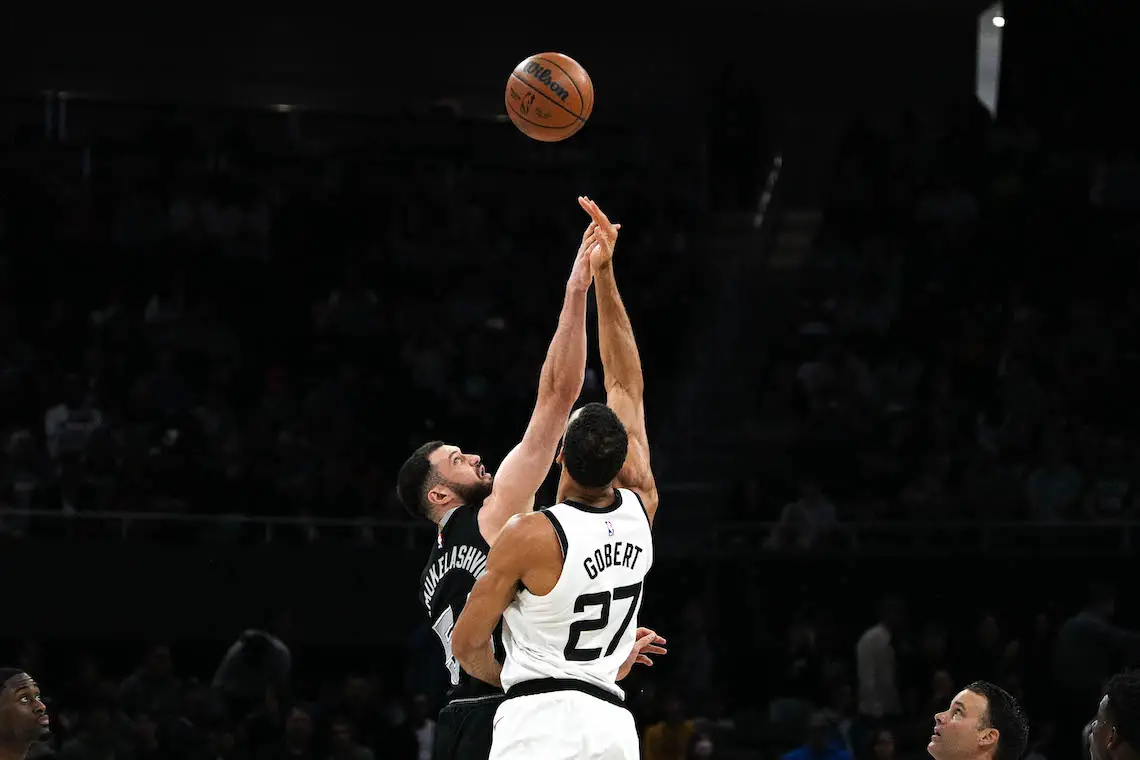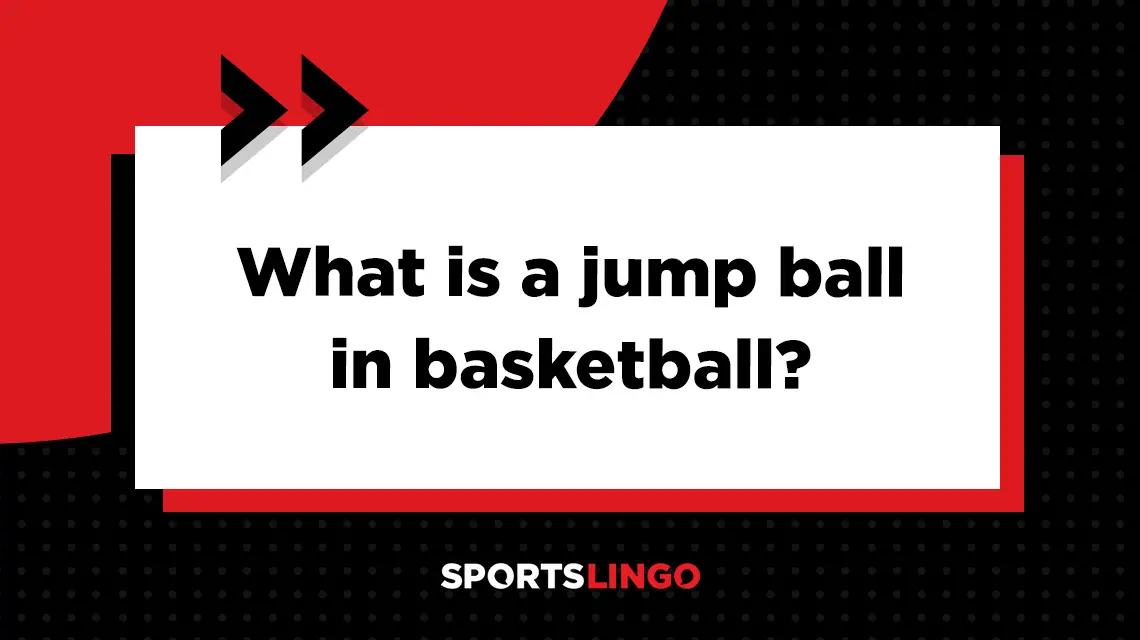jump ball
What is the definition of jump ball in basketball?
1. A jump ball is used to start or resume a basketball game. Two players from opposing teams try to gain possession of the ball after an official tosses the ball up into the air between them. The two players who are jumping for the ball attempt to tip the ball to a teammate. They cannot grab the ball out of the air and possess it themselves.
A jump ball can also be called after two opposing players are whistled for a held ball. When two opposing players grab the ball, are in equal possession of it and try to wrestle for possession, the official will call for a jump ball.
What is a jump ball in basketball games?
A jump ball is the official start to a basketball game. It’s also a way to restart play when players on opposing teams both have firm possession of the ball and one player isn’t able to wrestle the ball away successfully.
When used to begin a game, a jump ball is also commonly referred to as the tip-off or opening tip.
How is a jump ball executed?
At the beginning of the game and the start of each overtime period, one player from each team (usually the center, but it can be any player on the court) stands toe-to-toe at the half court line inside the center circle facing the basket where they will attempt to score. The official stands next to them facing one of the sidelines.
After blowing their whistle, the official tosses the ball straight up into the air between the two players, who both jump up and try to direct the ball toward one of their teammates. They can only touch the ball once it is on its way down from its apex.
If the jump ball occurs during the course of the game as a result of two players wrestling for possession, the two players involved must take the jump ball. The official tosses the ball at the nearest circle on the court, which will either be at the free throw line or half court.
What are the rules of a jump ball?
Some of the key rules for jump balls in basketball include:
- Besides jump balls used to begin the game or overtime periods (which always takes place at the half court line), the jump ball must be put into play at the circle closest to where play last occurred.
- Any two players can take the jump ball to begin the game, but other jump ball instances must be taken by the two players most closely involved with the play except in the case of injury or ejection from the game.
- Each player must have at least one foot on or inside their half of the jumping circle.
- Players may only touch the ball after it begins to come back down from its peak height.
- If neither player successfully taps the ball and it falls to the floor, an official will whistle to signal that the ball is dead and begin another toss.
- The players participating in the jump ball may not catch the ball until it’s touched by one of the other players on the court.
- The players not involved in the jump ball must remain still outside the jumping circle until the ball is tapped.
What is a jump ball violation?
A jump ball violation occurs when a player does one of the following:
- Contact the ball before it reaches its apex
- Catch the ball instead of tipping it to another player
- Jump before the ball is released
- Stand in the jumping circle if not involved in the jump ball
What does the referee do when they call a jump ball violation?
If a jump ball violation occurs, the referee will blow their whistle to stop the play and award the ball to the other team. They are permitted to throw it in from the sideline at the spot closest to where the violation took place.

Aaron E. Martinez/USA TODAY Sports
What is the alternating possession rule?
In some basketball leagues, the alternating possession rule automatically determines which team gets possession without the need for a jump ball. It is used in situations which would otherwise be settled with a jump ball, including:
- Held ball
- Free throw violation
- Technical foul
- Officials unable to determine which team is responsible for the ball going out of bounds
- Basketball wedges between the backboard and the rim when a player attempts a field goal
Instead of a jump ball, the alternating possession rule awards one team with a throw-in from the sideline at the spot closest to where the incident took place.
What is the purpose of the the alternating possession arrow?
When the alternating possession rule is in effect, an arrow is used to indicate which team will get the next possession in what would otherwise be a jump ball scenario. After a team gets a throw-in determined by alternating possession, the arrow is switched in the opposite direction to indicate that the other team will get the ball the next time.
The initial position of the alternating possession arrow is determined immediately following the jump ball that begins the game. The team who loses the jump ball has the arrow pointed toward them first. It continues to switch between the two teams for the remainder of the game, changing direction each time possession is determined by alternating possession.
The arrow used for the alternating possession rule also determines which team gets control of the ball for each period after the first half or quarter. The team with the possession arrow at the end of a half or quarter starts with the ball when the next period begins.
The alternating possession rule rule was first put into place in National Collegiate Athletic Association (NCAA) college basketball in 1981 and significantly reduced the number of jump ball situations in games. The rule is now commonly used in most lower-level leagues, including high school basketball. The International Basketball Federation (FIBA) adopted the rule in 2003, although this league decided to modify the rule to use the arrow instead of a jump ball to determine possession at the beginning of overtime periods.
Does the NBA use jump balls?
The National Basketball Association (NBA) uses jump balls at the beginning of the game and the start of any extra period. The NBA does not use the alternating possession rule, so jump balls are also used to settle held balls and other situations where it is unclear which team should receive possession of the ball.
What are the equivalents of a jump ball in other sports?
Similar methods are used to begin play and settle possession issues in other sports. For example, a face-off is used in ice hockey and field hockey to start a game or determine possession. In soccer, a kickoff begins each half of the game as well as any overtime periods and restarts play after each goal.
What does jump ball mean in slang?
When used colloquially, the term “jump ball” can refer to a competition that is too close to call and, as a result, the outcome is still up in the air. It could also be used to describe a situation in which two parties are given equal chances at an opportunity.
Examples of how jump ball is used in commentary
1. These two players from the Golden State Warriors and Boston Celtics are getting nowhere wrestling for the ball, so the official calls for a jump ball at the free throw line.
2. Anthony Davis wins the jump ball by deftly tipping it to his Lakers teammate Lebron James, who takes off dribbling, goes straight for hoop and dunks it, giving Davis an assist for the play.
Sport the term is used
1. Basketball
Also seen as:
1. Tip-off
2. Opening tip
